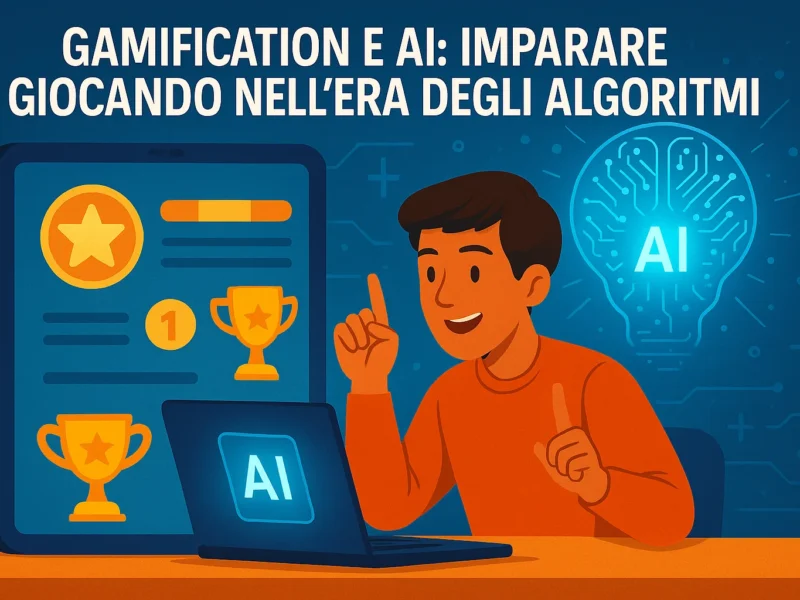When the game becomes a serious thing
Have you ever learned something while playing? Maybe it was a language with an app like Duolingo, or a historical notion, thanks to a video game educational? Today, the idea of learning while having fun is no longer a dream for a few fans. It is a true strategy, and it's called gamification. And when she meets artificial intelligence, the potential to multiply.
From the school to the company, through online courses, and app of the self-learning, gamification is transforming learning in an immersive experience. But what happens if orchestrating the whole thing is an intelligent algorithm?
What is gamification (and why it works)
The term gamification means the use of typical elements of game (challenges, rewards, levels, immediate feedback) in contexts playful, such as education or vocational training. The aim is to increase engagement, motivation and emotional involvement of the user.
It works because the game activates areas of the brain linked to pleasure and gratification. Instead of studying “for” obligation, you will learn why you want to win a challenge, complete a mission, or beat your own record. Psychology at the base is solid: reward systems, clear goals and objectives, the progress is visible.
And the artificial intelligence? Adds a key ingredient: the customization.
When the AI comes into play
Artificial intelligence allows you to adapt the learning experience in real-time. Analyze behaviors, recognizes the weak points, suggesting targeted exercises. In practice, it's like having a personal tutor who knows you better.
In educational contexts, this means that they can build tailor-made courses for each student, in a dynamic way. Who is faster, moves quickly; those in need of reinforcement, receives more support.
Also, the AI can generate content automatically, create challenges on measurement and even anticipate the moments when a student is about to lose motivation, intervening stimuli ad hoc.
We have already explored the subject in our article The AI in Education: A Future to Create and we're back to talk about it because it is a crucial point in the evolution of the school.
An OECD report analyses how the artificial intelligence and robotics will affect the economy and society, with particular attention to education and employment. OECD
Concrete examples, from school to business
A famous example is Kahoot!platform that transforms the quiz in a collective game. But with AI, you can do more. Advanced systems can create educational games that are based on the cognitive level of the user. Some startups are experimenting with augmented reality and artificial intelligence to make learning biology or history, immersively, through the missions and scenarios of the virtual.
In the corporate sector, the gamification is supported by the AI is already used in-house training, to assess soft skills and techniques, to simulate work environments and improve the engagement of employees.
Even the professional guidance can benefit from this synergy, as described in the article Work 4.0: AI and the Revolution Professional.
Risks and challenges to keep in mind
Of course, not everything is positive. If poorly designed, gamification can become a mechanism of control, prompting the user to follow a series of objectives to the surface, without any real learning. Artificial intelligence, from its part, is likely to create paths excessively standardized or, on the contrary, manipulative.
You need a balance between involvement and content, including customization, and respect for the natural time of learning. Teaching really increased, it should integrate technologies, and sensitivity to pedagogy.
Frequently asked questions (FAQ)
What is gamification and how it is different from a video game educational?
Gamification is an educational strategy that uses game mechanics in contexts that are not playful. A video game education is already a game. Gamification, however, becomes a serious activity into something more engaging.
According to Edutopia, the gamification transforms the traditional lessons in learning experiences that are engaging, using badges, levels, and rewards to motivate students. Edutopia
What are the benefits of using AI in education?
Customization, adaptability, real-time monitoring and smart recommendations. The AI can make the learning more effective and custom-made.
There are risks associated with the gamification with AI?
Yes. Mechanical too competitive, handling behaviour and / or loss of critical sense if there is a balance between play and learning authentic.
Conclusion: learning while having fun (seriously)
Gamification and artificial intelligence is dramatically changing the way we learn. From primary school to university, from corporate training to online courses for adults, more and more people discover that learning should not be boring.
Play is a serious thing. And the AI knows it well. But you need attention that behind every badge, every level unlocked, each of the quiz is interactive, there are data, algorithms, and choices pedagogical. The real challenge is to maintain a balance between the educational efficiency and respect for the person.
Do you want to explore other frontiers of education? Take a look at AI and Education: Teaching with Technology
